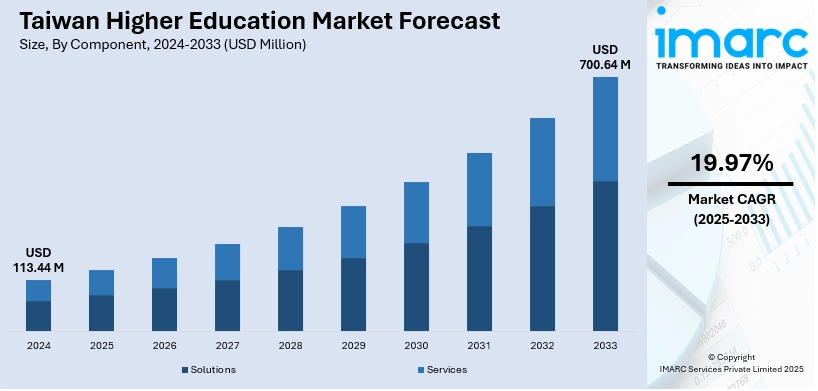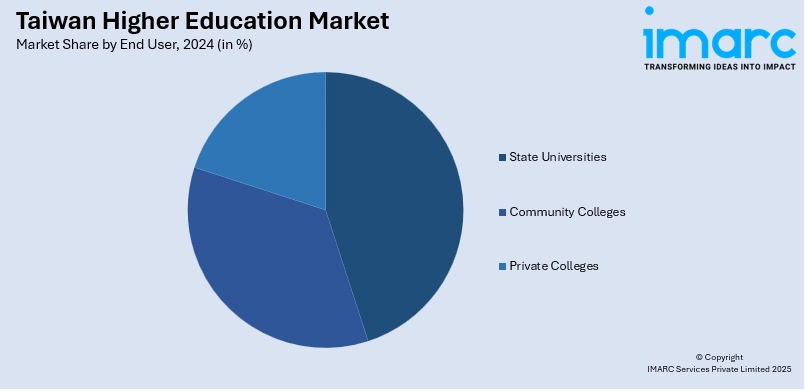
Taiwan Higher Education Market Size, Share, Trends and Forecast by Component, Deployment Mode, Course Type, Learning Type, End User, and Region, 2025-2033
Taiwan Higher Education Market Overview:
The Taiwan higher education market size reached USD 113.44 Million in 2024. Looking forward, IMARC Group expects the market to reach USD 700.64 Million by 2033, exhibiting a growth rate (CAGR) of 19.97% during 2025-2033. The market is driven by Taiwan’s strategic emphasis on internationalization, including active student recruitment across Southeast Asia and South Asia. Investments in digital learning technologies and smart campus infrastructure are transforming academic delivery systems nationwide. Additionally, deeper academic collaboration with key industry sectors ensures that higher education aligns with Taiwan’s innovation economy, further augmenting the Taiwan higher education market share.
|
Report Attribute
|
Key Statistics
|
|---|---|
|
Base Year
|
2024 |
|
Forecast Years
|
2025-2033
|
|
Historical Years
|
2019-2024
|
| Market Size in 2024 | USD 113.44 Million |
| Market Forecast in 2033 | USD 700.64 Million |
| Market Growth Rate 2025-2033 | 19.97% |
Taiwan Higher Education Market Trends:
Strategic Focus on International Student Recruitment
Taiwan’s higher education landscape has undergone significant restructuring to attract international students, particularly from Southeast Asia and neighboring regions. Through initiatives like the New Southbound Policy, the government has strengthened academic collaboration with ASEAN countries and India to promote Taiwan as an educational destination. Scholarship schemes, streamlined visa processes, and promotional campaigns in key partner nations contribute to this rising appeal. Universities are expanding English-taught programs to attract global enrollees and increase competitiveness within the Asia-Pacific educational ecosystem. Participation in international academic fairs, combined with institutional alliances abroad, enhances Taiwan’s visibility among prospective students. For instance, on June 12, 2025, TSMC and the University of Tokyo (UTokyo) jointly launched the “TSMC-UTokyo Lab” to advance semiconductor research, education, and talent incubation. The lab, TSMC’s first partnership of its kind outside Taiwan, builds on a collaboration that began in 2019, producing 21 research projects and introducing TSMC’s N16 FinFET technology into UTokyo’s curriculum. This initiative strengthens Taiwan’s position in semiconductor talent development and aligns with the growing emphasis on technology-driven programs in the Taiwan higher education market. Furthermore, academic exchange programs with foreign universities are supported by both public and private funding to facilitate cross-border mobility. Taiwan’s high standards in science, technology, engineering, and mathematics (STEM) disciplines are particularly attractive to students from developing economies. As these strategic efforts intensify, they directly contribute to Taiwan higher education market growth.

To get more information on this market, Request Sample
Growing Alignment of Academic Programs with Industry Needs
Taiwan’s universities are increasingly designing programs to produce industry-ready graduates in response to the demands of an advanced, technology-driven economy. Close partnerships between academic institutions and leading sectors, including semiconductor manufacturing, biotechnology, and renewable energy, are fostering curriculum alignment with real-world applications. This emphasis on global competitiveness is also reflected in Taiwan’s commitment to international academic exchange and cross-border collaboration. According to industry reports, more than 20,000 Taiwanese study in the US, and on the other hand, 4,000 Americans study in Taiwan. Such exchange programs not only foster cross-cultural learning but also strengthen academic networks that support Taiwan’s innovation-driven agenda. Cooperative education programs that combine classroom study with practical internships are gaining prominence, especially in engineering and applied sciences fields. University-based innovation hubs and start-up accelerators provide students with early exposure to entrepreneurship, contributing to Taiwan’s broader knowledge economy. The Ministry of Education encourages academic-industry engagement through competitive funding mechanisms for research with commercial potential. These collaborations help universities secure input from employers regarding skill requirements and future workforce projections. As Taiwan deepens its focus on innovation-driven industrial development, higher education institutions serve as critical channels for producing graduates equipped with specialized expertise. This responsive educational environment ensures alignment between national economic objectives and academic output, enhancing the market relevance of Taiwan’s university system.
Taiwan Higher Education Market Segmentation:
IMARC Group provides an analysis of the key trends in each segment of the market, along with forecasts at the country and regional levels for 2025-2033. Our report has categorized the market based on component, deployment mode, course type, learning type, and end user.
Component Insights:
- Solutions
- Student Information Management System
- Content Collaboration
- Data Security and Compliance
- Campus Management
- Others
- Services
- Managed Services
- Professional Services
The report has provided a detailed breakup and analysis of the market based on the component. This includes solutions (student information management system, content collaboration, data security and compliance, campus management, and others) and services (managed services and professional services).
Deployment Mode Insights:
- On-premises
- Cloud-based
The report has provided a detailed breakup and analysis of the market based on the deployment mode. This includes on-premises and cloud-based.
Course Type Insights:
- Arts
- Economics
- Engineering
- Law
- Science
- Others
The report has provided a detailed breakup and analysis of the market based on the course type. This includes arts, economics, engineering, law, science, and others.
Learning Type Insights:
- Online
- Offline
The report has provided a detailed breakup and analysis of the market based on the learning type. This includes online and offline.
End User Insights:

- State Universities
- Community Colleges
- Private Colleges
The report has provided a detailed breakup and analysis of the market based on the end user. This includes state universities, community colleges, and private colleges.
Regional Insights:
- Northern Taiwan
- Central Taiwan
- Southern Taiwan
- Eastern Taiwan
The report has also provided a comprehensive analysis of all major regional markets. This includes Northern Taiwan, Central Taiwan, Southern Taiwan, and Eastern Taiwan.
Competitive Landscape:
The market research report has also provided a comprehensive analysis of the competitive landscape. Competitive analysis such as market structure, key player positioning, top winning strategies, competitive dashboard, and company evaluation quadrant has been covered in the report. Also, detailed profiles of all major companies have been provided.
Taiwan Higher Education Market News:
- On May 8, 2025, the 2025 Taiwan–India Higher Education Leaders Forum was held in New Delhi, marking the 30th anniversary of Taiwan-India relations and focusing on collaboration in semiconductor technology and sustainable development. The forum brought together 44 delegates from 15 Taiwanese universities and representatives from 42 Indian universities, with nearly 70 university leaders participating in discussions on technological innovation and joint research. The signing of the third renewal of the memorandum of understanding between AIU and FICHET further solidified strategic academic partnerships.
- On May 28, 2025, a delegation of 43 representatives from 17 Taiwanese universities participated in the NAFSA 2025 Annual Conference & Expo in San Diego to strengthen Taiwan-U.S. higher education cooperation. Nearly 10,000 participants from 100 countries attended the event, where Taiwan showcased its integration of higher education with technology, emphasizing its role as a global "Technology Hub." The forum also highlighted Mandarin education initiatives, with nearly 3,000 American students currently studying Mandarin in Taiwan, bolstering the Taiwan higher education market.
Taiwan Higher Education Market Report Coverage:
| Report Features | Details |
|---|---|
| Base Year of the Analysis | 2024 |
| Historical Period | 2019-2024 |
| Forecast Period | 2025-2033 |
| Units | Million USD |
| Scope of the Report |
Exploration of Historical Trends and Market Outlook, Industry Catalysts and Challenges, Segment-Wise Historical and Future Market Assessment:
|
| Components Covered |
|
| Deployment Modes Covered | On-premises, Cloud-based |
| Course Types Covered | Arts, Economics, Engineering, Law, Science, Others |
| Learning Types Covered | Online, Offline |
| End Users Covered | State Universities, Community Colleges, Private Colleges |
| Regions Covered | Northern Taiwan, Central Taiwan, Southern Taiwan, Eastern Taiwan |
| Customization Scope | 10% Free Customization |
| Post-Sale Analyst Support | 10-12 Weeks |
| Delivery Format | PDF and Excel through Email (We can also provide the editable version of the report in PPT/Word format on special request) |
Key Questions Answered in This Report:
- How has the Taiwan higher education market performed so far and how will it perform in the coming years?
- What is the breakup of the Taiwan higher education market on the basis of component?
- What is the breakup of the Taiwan higher education market on the basis of deployment mode?
- What is the breakup of the Taiwan higher education market on the basis of course type?
- What is the breakup of the Taiwan higher education market on the basis of learning type?
- What is the breakup of the Taiwan higher education market on the basis of end user?
- What is the breakup of the Taiwan higher education market on the basis of region?
- What are the various stages in the value chain of the Taiwan higher education market?
- What are the key driving factors and challenges in the Taiwan higher education market?
- What is the structure of the Taiwan higher education market and who are the key players?
- What is the degree of competition in the Taiwan higher education market?
Key Benefits for Stakeholders:
- IMARC’s industry report offers a comprehensive quantitative analysis of various market segments, historical and current market trends, market forecasts, and dynamics of the Taiwan higher education market from 2019-2033.
- The research report provides the latest information on the market drivers, challenges, and opportunities in the Taiwan higher education market.
- Porter's five forces analysis assist stakeholders in assessing the impact of new entrants, competitive rivalry, supplier power, buyer power, and the threat of substitution. It helps stakeholders to analyze the level of competition within the Taiwan higher education industry and its attractiveness.
- Competitive landscape allows stakeholders to understand their competitive environment and provides an insight into the current positions of key players in the market.
Need more help?
- Speak to our experienced analysts for insights on the current market scenarios.
- Include additional segments and countries to customize the report as per your requirement.
- Gain an unparalleled competitive advantage in your domain by understanding how to utilize the report and positively impacting your operations and revenue.
- For further assistance, please connect with our analysts.
 Request Customization
Request Customization
 Speak to an Analyst
Speak to an Analyst
 Request Brochure
Request Brochure
 Inquire Before Buying
Inquire Before Buying




.webp)




.webp)












